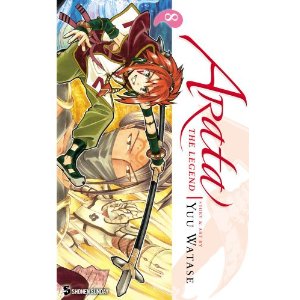It took seven volumes, but I am finally starting to warm up to Arata. I always thought it was well-executed because Yuu Watase is such a pro, but I wasn’t feeling as much of a connection to this series just because I tend to prefer her shoujo work. But these two volumes were packed with adventure and I found myself enjoying Arata’s quest more because the emotional stakes for Arata were raised in a variety of ways.
Arata Volume 7
I skipped volume 6, but the recently introduced complication that seems like a slightly recycled plot from Fushigi Yugi is that Arata’s school enemy in Japan, Kadowaki has now journeyed into Amawakumi and has become a Sho himself in opposition to Arata. The volume opens with Arata traveling to Lord Yorunami’s land, where Kotoha promptly gets kidnapped and placed into a watery death trap. Arata’s struggle with Yorunami ends up being more of an internal and emotional struggle than a violent fight, and when Arata helps Yorunami with his mother issues the Sho promptly surrenders because he is newly at peace. While Arata is able to fight one battle without using violence, he gets some disturbing news from the Original Arata who has taken his place in Japan. He finds out that Kadowaki has jumped into his adoped world, and the Sho Harunawa has killed Arata’s friend Suguru. Harunawa has vowed that for every Sho that submits to Arata, he will find a way to kill someone precious to Arata on the other side. Original Arata vows to protect Arata’s family so Arata can continue his mission. Arata picks up a new companion, the pretty but harsh warrior Mikusa, who has a secret that is tied to his prettiness.
Arata’s commitment to achieving his quest through non-violence is a nice contrast to all the fighting shonen manga out there. His strength comes mostly from resoluteness of character. Even though he does fight with other Sho to make them submit, the battles are won due to Arata’s internal strength as opposed to an outward show of power.
Arata Volume 8
Arata and his companions travel to Lord Kugura’s area of the country where they make some disheartening discoveries. The water is stagnant, land barren, and the regular people are starving. Girls are taken to the palace as “tribute,” but they are actually hostages. Mikusa challenges Arata’s approach to his quest, calling him naive, saying “Evil must be destroyed. If you are not the one capable of destroying it, then you are the one who will be killed.” Arata loses a strong ally when Kanate finds out that the gang that he used to belong to is in the hills. His reunion doesn’t go as planned, and when he has the opportunity to become powerful himself by inheriting the weapon of a Sho, he takes it. Kanate’s response to power shows the true destructive power of a Sho, which stands in contrast to Arata’s measured actions. Arata still maintains his friendship with Kanate after he disappears, saying “I still believe in him!”
Lord Kugura’s predilection for young women of course results in some cross-dressing hijinks, as Arata and his group decide they have to pretend to be female in order to enter the palace. The tone of this episode was definitely on the lighter side, which balanced out the earlier adventures that had more emotional heft. Overall, I’m finding myself enjoying Arata much more than I was in the earlier volumes. I’m finding the way Arata is literally carrying the souls and powers of his former enemies along with him, asking them for help when he has to fight an interesting contrast to the more typical shonen hero. It almost seems like Watase is writing an anti-shonen shonen adventure, with non-violence and the bonds friendship emphasized over physical fighting. I’m more intrigued with this series than I was when I first started reading it, so I’m looking forward to the next volume.
Review copies provided by the publisher.
